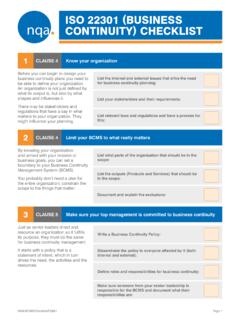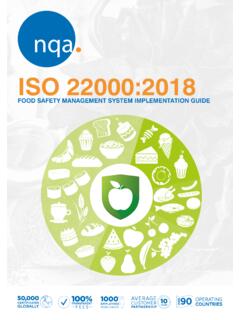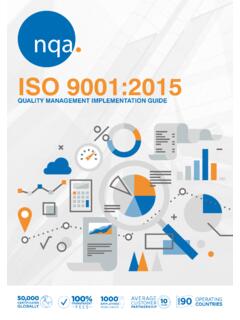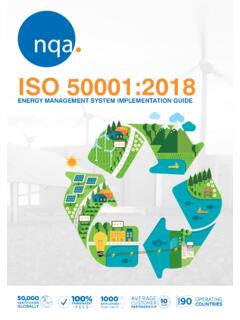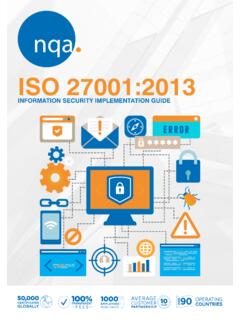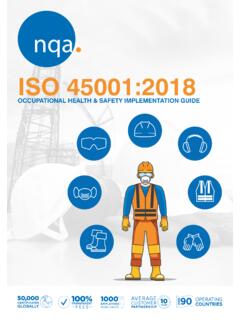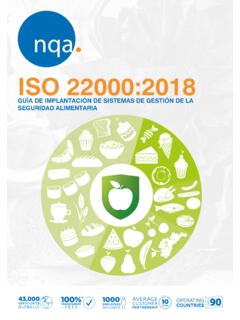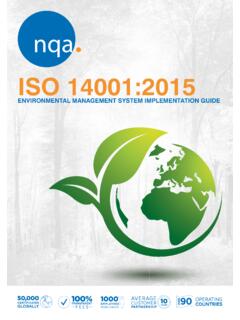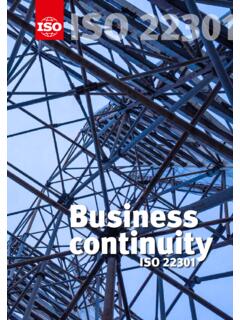Transcription of ISO 22301:2019 - NQA
1 iso 22301 : 2019 BUSINESS CONTINUITY STANDARD IMPLEMENTATION GUIDE50,000 GLOBALLYCERTIFICATES90 TRANSPARENTISO 22301: 2019 IMPLEMENTATION GUIDE2> iso 22301 : 2019 IMPLEMENTATION GUIDEISO 22301: 2019 IMPLEMENTATION GUIDE3 ContentsIntroduction to the standard P04 Benefits of implementation P06 Key principles and terminology P08 PDCA cycle P09 Risk based thinking / audits P10 Process based thinking / audit P11 Annex SL P12 CLAUSE 1: Scope P13 CLAUSE 2: Normative references P14 CLAUSE 3: Terms and definitions P15 CLAUSE 4: Context of the organization P16 CLAUSE 5: Leadership P18 CLAUSE 6: Planning P20 CLAUSE 7: Support P22 CLAUSE 8: Operation P24 CLAUSE 9: Performance evaluation P26 CLAUSE 10: Improvement P27 Get the most from your management P28 Next steps once implemented P29 Business Continuity Management Training P30 iso 22301 : 2019 IMPLEMENTATION GUIDE4 INTRODUCTION TO THE STANDARDISO 22301: 2019 IMPLEMENTATION GUIDE4 The ISO 22300 FamilyOrigin of the iso 22301 standard heralds back to the ISO technical committee ISO/TC 23, which focussed on addressing concerns related to societal security.
2 The standard is now managed by ISO/TC 292 - Security and Resilience. The first iteration of the iso 22301 standard was published in 2012. The second edition was published in October 2019 and is the focus of this implementation guide. There are currently 11 standards in the ISO 22300 series. The other standards in the series provide more detailed guidance and requirements for specific issues related to business continuity. This ranges from emergency response management through to mass evacuations. Regular Reviews and UpdatesISO standards are subject to review approximately every five years to assess whether an update is most recent update to the iso 22301 standard in 2019 brought about a number of changes. Whilst previous edition (2012) was one of the forerunner standards in adopting an Annex SL type format, the new edition firmly aligns the standard with Annex SL.
3 The 2019 version of the standard is reflective of the broader movement of ISO standards towards the application of risk based thinking, understanding organizational context and satisfying the needs of interested parties. The 2019 version contains less prescriptive requirements and is more flexible in its approach to documented information. The 2019 version additionally includes the new requirement to effectively plan changes to the Business Continuity Management System (BCMS). iso 22301 : 2019 is the latest version of the international standard for Business Continuity Management Systems. This standard provides a best practice framework to support organizations to effectively manage the impact of a disruption to its normal purpose of the standard is not necessarily to achieve total mitigation of impact from disruption. It is to support an organization to understand the amount and type of impact it is willing to accept following a disruption.
4 Following which the organization develops a business continuity system sized correctly for the organizational need. Many organizations will at some point experience a business disruption. The cause and nature of disruptive events is ever-changing. Organizations need to be able to think dynamically about this changing threat landscape and put in place appropriate plans to mitigate the series, the most important standards for an organization seeking to implement an effective Business Continuity Management System are: ISO 22300:2018 - Security and resilience Vocabulary iso 22301 : 2019 - Security and resilience Business Continuity Management Systems Requirements ISO 22313:2020 - Security and resilience Business Continuity Management Systems Guidance. Provides helpful direction in support of the practical implementation and operation of a business continuity systemISO 22301: 2019 IMPLEMENTATION GUIDE5 iso 22301 : 2019 IMPLEMENTATION GUIDE5 iso 22301 : 2019 IMPLEMENTATION GUIDE6 BENEFITS OF IMPLEMENTATIONVISIBLE RESILIENCEAn effective BCMS provides evidence to current and potential customers of organizational preparedness for disruption.
5 This is particularly important in sectors where disruption can have significant impacts on people s lives as well as financial impacts; including government, healthcare, financial, defence, social services. COMPETITIVE ADVANTAGEB eing able to continue to operate during or shortly after a disruption gives a company a competitive advantage. In the short term it may be able to win business from competitors which are unable to operate or are doing so in a diminished capacity. In the longer term, a company can generate reputational benefits that will attract customers as well as benefit from stronger financial addition, a Business Continuity Management System supports an organization to bid or tender more ORGANIZATIONAL VALUEA BCMS helps to mitigate the negative impact of a disruptive event. Practically speaking, this can save the organization significant amounts of money, time and reputational impact.
6 PEACE OF MINDThe future is uncertain. An effectively implemented BCMS gives an organization confidence to move forward knowing it can manage a disruption. This peace of mind spans the organization from personnel operations teams to board CYBER SECURITY AND IT FAILURE RESILIENCEC yber security and IT disaster planning is high on the agenda of many organizations. A business continuity plan supports a company to manage the impact of the IT disruption. This can be by malicious action or from infrastructure failure. Crypto viruses, DDoS attacks and data centre failures can create deep and long lasting disruption to all functions of an organization. Cyber security certifications such as ISO 27001 and Cyber Essentials do not fully address continuity challenges in the event of a disruption. The ISO 27001 attempts to address continuity within the IT function itself but this does not extend to the rest of the organization.
7 iso 22301 provides a framework for addressing the wider organizational impact of IT failure. As a result, a Business Continuity Management System ( iso 22301 ) is well suited to be integrated with an ISO 27001 information security management system. It has been demonstrated in recent times that a company s ability to manage disruptive events is becoming central to its survival. The variety of threats which can cause business disruption is ever-increasing. From cyber-attacks and global pandemics to natural disasters; an organization needs a toolset to manage itself through uncertain times. In the past, business continuity planning tended to be reserved for critical national infrastructure and major corporations. Today, business continuity is an issue that affects practically all organizations to some degree. A correctly implemented Business Continuity Management System should be scaled to the size and complexity of the organization making it suitable for SME and large corporation core purpose of a Business Continuity Management System is to enable the mitigation of a disruption.
8 Depending on the organization the benefits this will work in support of its goals; whether that is to save lives in a hospital or to reduce financial impact to a manufacturing 22301: 2019 IMPLEMENTATION GUIDE6 iso 22301 : 2019 IMPLEMENTATION GUIDE7 iso 22301 : 2019 IMPLEMENTATION GUIDE7 High Level ViewA Business Continuity Management System operates on similar principles to other management systems. The system is built on the Plan-Do-Check-Act model. Determine the organizational needs and understand the rationale for business continuity plans: What is important to continue in the event of a disruption Why is that important and to whom? What level of disruption is the organization and its stakeholders prepared to accept? Putting in place a framework for achieving the mitigation of the disruption. This can include: Processes Capabilities Response structures Check the performance and effectiveness of the system through monitoring.
9 Practically speaking this will involve testing BC plans through various means. Improve the system based on measures established, revisit the rationale for the business continuity plans and their alignment to what has been implemented. One of the practical challenges with BCMS is that it comes into action infrequently. Whilst quality management systems are implemented into the company s day to day operation, business continuity systems are only fully brought into action when a disruption occurs. This means there needs to be a greater emphasis on: Business continuity plan (BCP) testing or drills Retaining and refreshing organizational capabilities to support business continuity Periodic reviews of the system, its processes and rationale to ensure it remains aligned to a changing 22301: 2019 IMPLEMENTATION GUIDE8 KEY PRINCIPLES OF BUSINESS CONTINUITYB usiness continuity is grounded in a number of key principles which need to be consistently applied to a business continuity system for it to be effective.
10 iso 22301 : 2019 IMPLEMENTATION GUIDE8An organization s senior management and board of directors are responsible for business continuity, this responsibility must be understood and accepted. Business continuity management should be an integral component of overall risk management. In the event of a disruption, the absence of clearly defined responsibilities, authorities and roles can cause a business continuity plan to become ineffective. An organization should have in place clear business continuity objectives that reflect the nature of their activities and their impact on stakeholders. This supports the prioritisation and resource allocation to the business continuity process. These objectives should clearly define the expected continuity levels and continuity business continuity standard is different from others in that it focusses on the what if.
